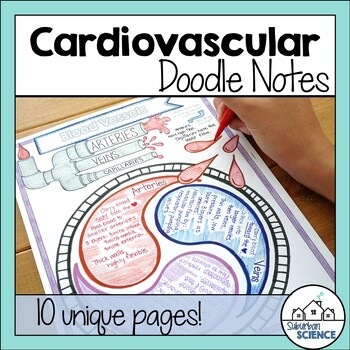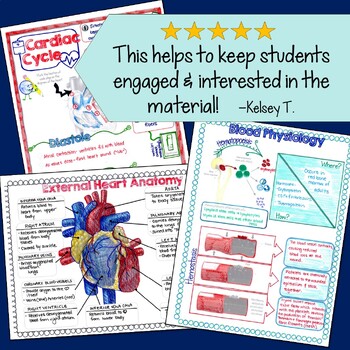Anatomy Doodle Notes - Cardiovascular System Doodle Notes- Heart & Blood Vessels
- Zip
What educators are saying
Also included in
- This is a HUGE bundle of doodle notes, diagrams, and worksheets that are made to align with your Anatomy and Physiology or Health Science curriculum! Over 90 pages of beautifully designed, engaging doodle notes that will save your sanity and add creativity to your classroom! SAVE 25% with this bigPrice $95.00Original Price $132.50Save $37.50
Description
Need to spice up your lessons on the cardiovascular system? 10 pages of highly visual Cardiovascular System doodle notes notes will keep your Anatomy students engaged while summarizing tricky topics like composition of blood, blood typing, blood flow through the heart, and more! Doodle notes are a fun method of note-taking that aids in memory by utilizing both hemispheres of the brain. Your students will love it!
_______________________________________________________________
Teaching virtually this year?
These doodle notes also come with a digital option through Google Slides (TM) so students can use a device to type on or color the pages.
Tips for using these in-class and digitally are also included.
_______________________________________________________________
Included Pages/Topics:
- Composition of blood (plasma, white blood cells, red blood cells, platelets)
- Leukocytes (types of agranulocytes & granulocytes)
- Blood physiology (hematopoiesis, hemostasis)
- Blood typing (antigens & antibodies for each blood type)
- External anatomy of the heart & major blood vessels
- Internal anatomy of the heart (atria, ventricles, valves)
- Layers of the heart & circulation loops
- Cardiac cycle (SA node, AV node, diastole, systole)
- Cardiac output (effects of heart rate & stroke volume)
- Blood vessels (arteries, veins, capillaries)
Each page includes:
-A gray student version (Gray is perfect for illustrated notes because your students' coloring really shows up well on the page!)
-A typed answer key for each page
-A photograph of a student example for each page
**For details on the topics included in this resource, CLICK on the PREVIEW button above.**
_________________________________________________________________
Have a 1:1 classroom with digital learners?
These doodle notes also come with a digital option for completing on a device.
Need a unit plan, Power Point, labs & activities, or other resources for the Cardiovascular System? Find them in the full unit here: Cardiovascular System Unit
Interested in other Doodle Notes? Check out these resources:
________________________________________________________________________
⭐For updates about sales and new products, please follow my store: My TpT Store
You can also
⭐Subscribe to my newsletter for freebies and teaching tips
⭐Follow me on Instagram
⭐Check out my Facebook page
⭐Follow me on Pinterest
I value your feedback. Please rate this product. If you have any issues or questions about this product, please feel free to ask a question in my store or write to me at support@suburbanscience.com.
________________________________________________________________________
Doodle notes is a trademarked term used with permission. Please visit doodlenotes.org for more information.






